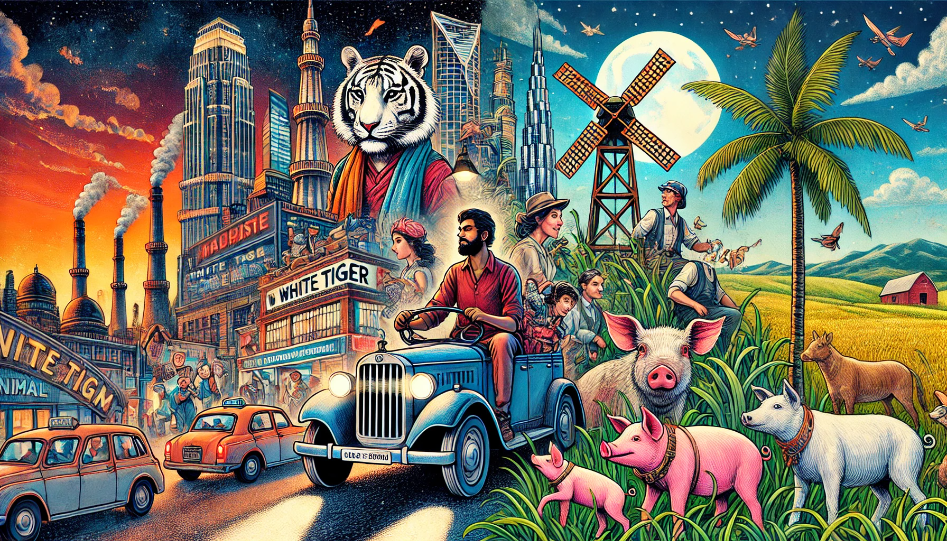Discovering the Depths of "The White Tiger" and "Animal Farm"

Introduction
In the realm of literature, some books stand out for their profound impact and unique storytelling. "The White Tiger" by Aravind Adiga and "Animal Farm" by George Orwell are two such books that continue to captivate readers worldwide. For authors and literary enthusiasts, exploring these works offers valuable insights into narrative techniques, socio-political commentary, and character development. In this article, we will delve into the essence of "The White Tiger" and "Animal Farm," highlighting their themes, characters, and relevance in today's world. Whether you're an author seeking inspiration or a reader with a penchant for thought-provoking literature, this article is your gateway to understanding these masterpieces.
The White Tiger: A Modern Classic
Overview
"The White Tiger," published in 2008, is a compelling novel that won the Man Booker Prize. Aravind Adiga's debut novel presents a dark and gritty tale of India's class struggle, corruption, and the quest for freedom. The story is narrated by Balram Halwai, a poor villager who becomes a successful entrepreneur through morally questionable means.
Themes and Analysis
- Class Struggle and Social Mobility: The novel paints a vivid picture of the vast divide between the rich and the poor in India. Balram's journey from a servant to a businessman highlights the challenges and ethical compromises involved in social mobility.
- Corruption and Morality: Adiga explores the pervasive corruption in Indian society, questioning the moral fabric of its characters. Balram's actions, while reprehensible, are portrayed as a product of the system he is trapped in.
- Identity and Transformation: Balram's transformation from a humble servant to a self-proclaimed "White Tiger" symbolizes his fight for identity and recognition in a society that marginalizes him.
Character Development
Balram Halwai is a complex character whose cunning and ambition drive the narrative. His internal monologues and letters to the Chinese Premier provide a unique perspective on his thoughts and motivations. The supporting characters, including his employer Mr. Ashok and his family, serve as representations of India's elite and their oppressive attitudes.
Relevance Today
"The White Tiger" remains relevant as it mirrors ongoing issues of economic disparity and corruption. Its adaptation into a successful Netflix film in 2021 has further cemented its place in popular culture, making it a must-read for contemporary audiences.
Animal Farm: A Timeless Allegory
Overview
Published in 1945, George Orwell's "Animal Farm" is an allegorical novella that critiques totalitarian regimes through the story of a group of farm animals who overthrow their human farmer. The animals' attempt to create an equal society ultimately leads to a dictatorship under the pigs, reflecting the rise of Stalinism.
Themes and Analysis
- Totalitarianism and Power: "Animal Farm" is a powerful critique of totalitarian regimes and the corrupting influence of power. Orwell uses the pigs' rise to control as a metaphor for the betrayal of revolutionary ideals.
- Propaganda and Manipulation: The novella explores how propaganda and manipulation can control and oppress the masses. Squealer, the pig, represents the use of propaganda to justify the pigs' actions and maintain their power.
- Equality and Inequality: Orwell delves into the theme of equality, showcasing how initial ideals of fairness and justice can be corrupted by those in power. The famous line, "All animals are equal, but some animals are more equal than others," encapsulates this transformation.
Character Development
The characters in "Animal Farm" are symbolic, with each animal representing different classes and roles within society. Napoleon, the pig, embodies the ruthless dictator, while Snowball represents the idealistic but ultimately doomed revolutionary. Other characters like Boxer, the hardworking horse, symbolize the exploited working class.
Relevance Today
"Animal Farm" remains a critical text in understanding the dynamics of power and corruption. Its lessons are applicable to modern political landscapes, making it essential reading for those interested in political science and history.
Drawing Inspiration for Authors
For authors, "The White Tiger" and "Animal Farm" offer rich sources of inspiration:
- Narrative Techniques: Both books employ unique narrative techniques. "The White Tiger" uses a first-person epistolary style, while "Animal Farm" employs allegory and satire. Exploring these techniques can help authors experiment with their storytelling methods.
- Character Arcs: The complex character arcs in both novels provide valuable lessons in character development. Understanding how Adiga and Orwell craft their protagonists' journeys can enhance an author's ability to create compelling characters.
- Social Commentary: Both books are renowned for their socio-political commentary. Authors can learn how to weave social issues into their narratives effectively, making their stories not only engaging but also thought-provoking.
Conclusion
"The White Tiger" and "Animal Farm" are timeless works that continue to resonate with readers and authors alike. Their exploration of class struggle, power, and morality offers profound insights into human nature and society. By delving into these masterpieces, authors can gain inspiration and understanding that will enrich their own writing. Whether you're new to these books or revisiting them, their relevance and impact remain undiminished, making them essential additions to any literary repertoire.
For further reading, you might also be interested in:



